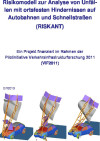RISKANT – Risk model for the analysis of accidents with stationary obstacles on highways und expressways
Short Description
Starting point / motivation
Road crashes with stationary obstacles along the road usually result in casualties and severe losses on traffic participants. In order to reduce those numbers, run-off-road accidents have to be prevented, seeing as there is a direct link between those two types of accidents.
Without run-off-road accidents, stationary obstacles along the road do not pose any harm for road users. On Austrian motorways, about 40% of all injury accidents are run-off-road crashes which account for nearly 50% of the fatalities on the primary road network.
This was one of the reasons why the Austrian Highways Agency (ASFiNAG) postulated in its road safety program until 2020 that new strategies and road safety measures had to be developed in order to prevent vehicles from running off the road and (in a worst case scenario) colliding with stationary obstacles on the roadside.
Contents and goals
In order to achieve the project goals, a so-called accident prediction model (APM) estimated the probabilities of run-off-road accidents due to characteristics of the road and the road environment. Furthermore, simulation studies were conducted to incorporate the severity of injuries due to stationary obstacles along the road side (safety zone). Potential measures to prevent run-off-road accidents and/or to reduce the severity of injuries due to such accidents were evaluated in terms of economy by means of cost-benefit analyses and prioritized.
Hence, the objectives of this project were:
- An estimation of the probability of run-off-road accidents due to characteristics of the road and its environment and classification of sections and/or road elements due to their run-off-road hazardousness.
- Conduction of simulation studies on the influence of different risk factors in the safety zone (area between the obstacle and the roadside) in order to get better knowledge on the relationship between risk factors and severity of injuries.
- verview on potential road safety measures and their effectiveness.
Methods
RISKANT used different algorithms and risk factors to overcome the weaknesses of traditional models and calculate a result which is as close to reality as possible.
This was accomplished by using methods for pattern recognition and data mining for classification of the hazardousness of road elements. The results as well as the simulation of accident-reconstruction by means of a software tool were used to collect additional variables and the extension of the sample, which were, at the moment, not yet included in official accident-statistics.
These goals were best accomplished by incorporating an accident prediction model (APM). APMs are special forms of risk models and had been increasingly used in the past few years as an efficient and coherent tool to estimate the influence of different road and environmental factors on accident numbers and severity of injuries. Accident Prediction Models enable the road administration to take into account several risk factors simultaneously and calculate the probability of having an accident when one of the factors changes.
Results and Conclusions
As a result, motorways can be differentiated into sections and/or elements where the probability of run-off-road accidents is high/medium or low. In order to incorporate the effects of different elements of the road environment on severity of injury, accident reconstruction and simulation studies were conducted.
The objective of this task was to enhance the knowledge of run-off-roads accidents and estimate the effect of different factors such as the distance of the object to the road side.
Furthermore, potential measures to prevent run-off-road accidents and/or to reduce the severity of injuries due to such accidents were evaluated in terms of economy by means of costbenefit analyses and prioritized. It is assumed that 20-30 fatalities per year on motorways and highways could be prevented by using a risk model for run-off-road crashes within the ASFiNAG safety management process.
Publications
RISKANT – Risk model for the analysis of accidents with stationary obstacles on highways und expressways

The objective of the RISKANT study was the development of a risk model for crashes with stationary obstacles along the road.
Priv.-Doz. DI Dr. Peter Maurer, DI Christian Stefan, DI Rainer Stütz, DI Dr. Ernst Tomasch, DI Peter Luttenberger, DI Christoph KleinN, Thomas Pistotnik
Publisher: BMVIT
German, 158 Seiten
Publication Downloads
Project Partners
Project manager
DI Dr. Christian Stefan - AIT Austrian Institute of Technology GmbH
Project Partners
Dr. Ernst Tomasch - Technical University Graz - Institute for Vehicle Safety (Member of Frank Stronach Institute)
Contact Address
AIT Austrian Institute of Technology GmbH
DI Dr. Christian Stefan
Tel.: +43 (0) 50-550-6329
E-mail: christian.stefan@ait.ac.at
